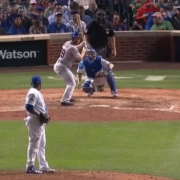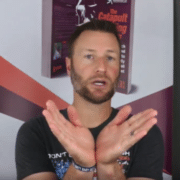Baseball Batting Stance That Will Reduce Strikeouts?
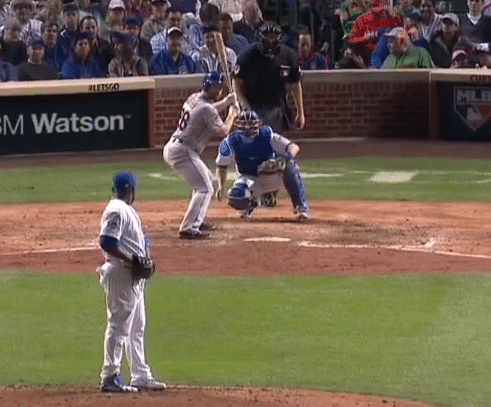
2015 Daniel Murphy in triple flexion (hip, knees, and ankles). Photo courtesy: MLB.com
This post will discuss the proper youth batting stance and how to improve power for both baseball and softball in 2022. Best open, square, closed, and wide stance information in addition to whether to keep the back elbow up or down hitting tips.
The baseball batting stance video post was sparked by my friend, whom I admire and respect as a man AND hitting instructor, doing great work in the San Diego-California area, Ryan Lehr (@thepureswingsd).
He’s worked under the hitting tutelage of Reggie Smith for over 15 years, and really has a fantastic grasp of the absolutes to the swing.
For those of you who don’t know Reggie Smith’s teachings, he’s as much of a ‘science-guy’ as we are.
And yes, this works for fastpitch softball as well as baseball.
The point of this video post, is to look at being in an athletic baseball batting stance and its effect on reducing strikeouts.
We’ll be looking at:
- Effective baseball batting stance context,
- Metrics of low-strikeout high-ISO hitters, and
- Which low-K% high-ISO MLB hitters to model?
Effective Baseball Batting Stance Context
Easier to Hit Difficult Pitches
At Ryan Lehr & Reggie Smith’s Christmas hitting clinic, Kevin Sweeney talked about how getting more athletic in his baseball batting stance allowed him to hit difficult pitches…
Mike Sweeney talking about how he became great. Stopped standing tall, & got in an athletic position! pic.twitter.com/la5njg4wVG
— Ryan Lehr (@thepureswingsd) December 21, 2015
Making Adjustments to Gravitational Forces
Taylor Gardner, founder of the Backspin Batting Tee, says that a first baseman stretches toward the thrown ball when receiving it. Knees are bent and the eyes are getting on level plane with thrown ball and receiving glove.
Gravitational Forces are acting on the ball at ALL times.
Here’s something that may piss off some fastpitch softball pitching coaches and pitchers…
Taylor Gardner came to the conclusion that a ‘rise-ball’ is a myth. And I AGREE!
And if you don’t believe us:
- Find your fastest fastpitch softball pitcher,
- Video record her throwing a ‘rise-ball’ from the side angle where you get her and the catcher in the same frame, and
- Track the trajectory of the ball’s flight to the catcher’s glove on slo-mo software…
I guarantee the apex of the pitched ball’s arc will be above where it’s caught by the catcher.
It’s because of GRAVITY!!!
Sure the arc will be less, the harder the pitcher throws, but there will still be an arc nonetheless.
Who Else Gets into an Athletic Position?
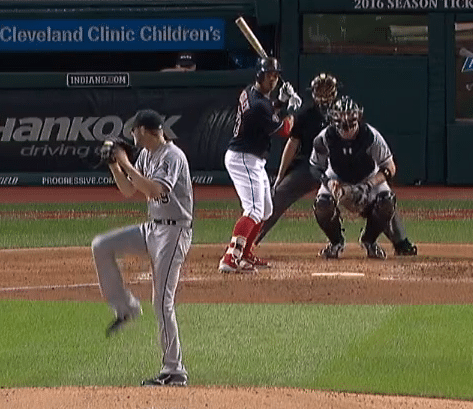
2015 Michael Brantley in triple flexion. Photo courtesy: MLB.com
I ask my players what knee position they’d start in if they were:
- Defending against a quickly advancing soccer striker,
- Defending a fast wide receiver five-yards off the line,
- The only one between a breakaway power forward and the hoop in basketball,
- Going to throw a 16-pound Shot Put as far as humanly possible, or
- Receiving a blazing serve from Roger Federer?
CLICK HERE for Speed Coach Lee Taft (@LeeTaft) blog post on why bending the knees is important to force production.
I alluded to the ‘triple flexion’ baseball batting stance in this video post breaking down Joey Votto’s swing.
Votto has one of the best swings to model if you want to cut down on ground-balls, strikeouts, weak fly balls, and just want to get on base more and make more frequent solid contact. He’s the ultimate Pitch-Plane Dominator!
Metrics of Low-Strikeout High-ISO Hitters
I wanted to compare the Strikeout Percentage and ISO metrics to see if we could find a correlation between the baseball batting stance and hitters who rarely strikeout, but also maintain some element of power.
One of the biggest MYTHS is that you can only be a contact hitter, or a power hitter. And that you can’t be both. Nowadays, SABERmetric people conclude that when homers go up, so does the rise of strikeouts.
My belief is there CAN BE more going on between the numbers…
When looking back in time, we saw quite a few examples of fusing minimal strikeouts and raw power…Hank Aaron, Ted Williams, Joe Dimaggio, and Babe Ruth to name a few.
Okay, so what is ISO? Isolated Power, according to FanGraphs.com basically describes a hitters “raw power”.
For you SABR wannabe math nerds (like me!), here’s a simple formula to compute ISO in two different ways:
- ISO = SLG minus AVG, OR
- ISO = Extra Bases divided by At-Bats
Here’s an excel spreadsheet I put together, using FanGraph.com’s metrics, on the top-5 highest and lowest strikeout percentages among 2015 hitters, their ISO’s, and dinger totals:
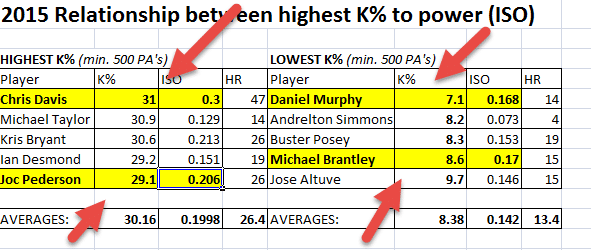
We analyze the highlighted hitters in the above video. Daniel Murphy and Michael Brantley having virtually above average ISO’s…
Compare how these hitters rank for K%:
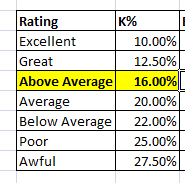
According to Fangraphs.com
Compare how these hitters stack up for ISO:

According to FanGraphs.com
What’s plain as day is how ‘awful’ the top-5 highest K% are. Eee-gads! Not even trying there 😛
The silver lining though, is that there are a couple top-5 lowest K% that have virtually above average ISO’s, and one I’m excited to see perform in 2016 with a change in his baseball batting stance toward the end of the 2015 season…
Which Low Strikeout MLB Hitters to Model?

Notice Joc Pederson baseball batting stance change – left image is halfway through 2015 & right image is at the end of 2015. Photo courtesy: MLB.com
As Tony Robbins says, “Success leaves clues”. He also said,
“If you want to be successful, find someone who has achieved the results you want and copy what they do and you’ll achieve the same results.”
If you’re the coach (or hitter) who’s goal it is to reduce strikeouts among your hitters, while also preserving some elements of power, whose swing should you model?
…At least from a baseball batting stance point of view?
After analyzing the metrics, my answer’s are:
- Daniel Murphy,
- Michael Brantley, and
- Joc Pederson (the end of 2015 baseball batting stance version).
Watch the video above for more in-depth analysis of these hitters.
I’m not sure how many strikeouts Joc Pederson had without ‘triple flexion’ in 2015 versus with it, but I’m anticipating way less strikeouts for him in 2016 if he keeps this principle in his baseball batting stance. He’s a special hitter, and not a very big slugger (6’1″, 215-pounds).
Also, I know that correlation may not equal causation in this case, but it’s worth looking into. So I’d love your thoughts and analysis on other low K% hitters with above average ISO’s…
To be continued… 😉

